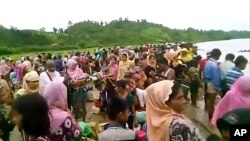The Rohingya refugee crisis is an age-old tale of displacement and suffering, but technology is providing new tools to tackle it, rights groups and charities said on Wednesday.
Powerful drone and satellite images are bringing to life the urgent needs of more than 800,000 Rohingya refugees who fled to Bangladesh from Myanmar, while also providing strong evidence of abuses, which could be used to lobby for justice.
“We can describe for hours the large numbers of refugees crossing the border and how quickly existing camps have expanded, but one image captures it all,” said Andrej Mahecic, a spokesman for the United Nations refugee agency (UNHCR).
More than 600,000 Rohingya have fled to neighboring Bangladesh since the military in predominantly Buddhist Myanmar launched a counter-insurgency operation after attacks on security posts by Rohingya militants in late August.
The UNHCR is using videos and photographs shot with drones to show the scale of the displacement crisis and bring it to life to spur action from the public and donors.
It is also using satellites to count and identify refugee families by their location in the Bangladesh camps to target assistance to those most in need, Mahecic told the Thomson Reuters Foundation in an email.
The use of drone footage of refugees entering Bangladesh has boosted donations for medical care, water and food, according to the Disasters Emergency Committee (DEC), an alliance of 13 leading British aid agencies.
Rights monitors also hope satellite images can provide evidence that to help bring perpetrators to justice.
Satellite photos were used in the International Criminal Tribunal for the former Yugoslavia (ICTY) to prove mass executions in 1995 in Srebrenica.
But the technology has yet to achieve its potential because of limited budgets and a lack of standardised methodologies accepted by courts, experts say.
Human Rights Watch has shared satellite images showing the burning of almost 300 villages in Myanmar, refugees' mobile phone footage and their testimonies with the Office of the High Commissioner for Human Rights.
“We have found the debris field in satellite imagery where people were executed, corroborating multiple eyewitness statements,” said Josh Lyons, a satellite imagery analyst with the U.S.-based rights group.
The U.N. High Commissioner for Human Rights Zeid Ra'ad al-Hussein has called the violence against Rohingya in Myanmar “a textbook example of ethnic cleansing,” and his office is working to determine whether it meets the legal definition of genocide.









